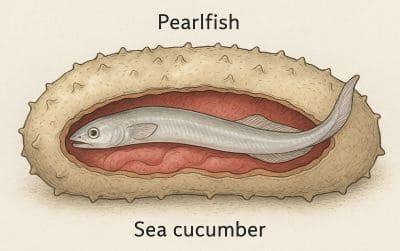Home › Sea Animals › Marine Species › Vertebrates › Pearlfishes
Interesting Facts about Pearlfishes
[Pearlfish Phylum: Chordata] [Class: Actinopterygii] [Order: Ophidiiformes] [Family: Carapidae]
There are plenty of fishes in the sea, but surely none are as fascinating or weird as the little commensal creatures that live inside the anus of their hosts?
This guide contains some extraordinary and unique facts about pearlfishes (Carapidae), especially where they hide, what they eat, and how these small ray-finned fish reproduce.
Pearlfish Geographical Range and Habitats
There are about thirty (30) known species of pearlfishes, and most of them live in tropical and subtropical seas.
They thrive best in shallow reefs and oceanic shelves, such as those in the Atlantic, Indian, and Pacific Oceans.
Even so, some of the deep water pearlfish species inhabit much deeper water at depths approaching 2,000 metres.
Even though they are shy and somewhat secretive marine fish, divers are most likely to spot a pearlfish in a reef zone where sea cucumbers (Holothuroidea) are present.
They are ray-finned marine vertebrates that deploy a strictly defencive strategy when they feel threatened. Hence, they rely on a safe place to hide rather than getting involved in any kind of a fight for superiority.
Pearlfish Behaviour and Characteristics
Pearlfish have ectocommensal relationships with other creatures, and they will retreat inside their host organism at the first sign of danger - which very often will be via the anus of sea cucumber.
Their slender and flexible body form means they are able to slip inside tight crevices or tiny anatomical cavities. In addition, the pale brown colouration helps them to remain inconspicuous in dimly lit environments.
Here's the bottom line:
The rather strange choice of habitat is the most distinctive trait in all pearlfishes. They are 'famous' for living inside the bodies of other marine creatures, such as sea stars, pearl oysters, clams, tunicate sea squirts, and amber fish sea cucumber (Thelenota anax).
Some species exhibit commensal symbiosis, such as remoras attached to sharks, where the host is simply used as shelter and suffers no significant harm.
Whereas, others are parasitic and feed on the host's internal tissues (including their gonads). So you could say, it's a kind of relationship that varies between a 'harmless roommate' and a 'freeloader' with a nasty bite.
Let's move on...
The scaleless body is elongated and slender, similar to that of eels. Even though most of the pearlfish classification are semi-transparent, some have silver coloured sides.
The average size ranges between five and twenty (20) centimetres (up to 8 inches long). Even though they lack pelvic fins, their dorsal and anal fins run the entire length of their body - sometimes merging into the tail fin.
What Do Pearlfishes Eat?
The family Carapidae (the pearlfishes) are mostly nocturnal, so many will need to leave the safety of their shelter during the dark hours to feed.
 Depending on the species, the daily diet of the opportunistic feeders will include:
Depending on the species, the daily diet of the opportunistic feeders will include:
- Crustaceans (e.g., caridean shrimp)
- Detritus matter
- Small fish
- Polychaete worms
Whereas, the parasitic species of pearlfish feed on a host's internal organs, such as:
- Gonads (sex organ of sea cucumbers)
- Muscles
Fun Fact: Some pearlfish species are capable of producing sounds, thought to be used in communication or as a kind of territorial defencive mechanism.
Types of Pearlfish Species
Atlantic Pearlfish (Carapus bermudensis)
Closefin Pearlfish (Echiodon anchipterus)
Cucumber Pearlfish (Onuxodon margaritiferae)
Dawson Pearlfish (Echiodon dawsoni)
Drummond Pearlfish (Echiodon drummondii)
European Pearlfish (Carapus acus)
Fowler's Pearlfish (Onuxodon fowleri)
Graceful Pearlfish (Encheliophis gracilis)
Oyster Pearlfish (Onuxodon parvibrachium)
Pacific Pearlfish (Carapus dubius)
Pinhead Pearlfish (Carapus boraborensis)
Pygmy Pearlfish (Encheliophis vermiops)
Rendahl's Messmate (Echiodon rendahli)
Silver Pearlfish (Carapus homei)
Sluiter's Pearlfish (Carapus sluiteri)
Star Pearlfish (Carapus mourlani)
Worm Pearlfish (Encheliophis vermicularis)
How Do Pearlfish Reproduce?
The reproductive strategies of pearlfish are similar to most oviparous fish species. A female lays a gelatinous raft of eggs in the open water to be fertilised by a male.
Pearlfish larvae become free-swimmers in the water column until they find a suitable host. As juveniles, they will use chemical or sensory cues to locate a host organism and then enter inside it to begin their adult life.
Pearlfish Predators and Threats
So, what kind of animal would be comfortable eating a pearlfish? Even though they have a habit of hiding inside sea cucumbers, in fact they are prey for a variety of large ocean predators, especially:
- Carnivorous reef fishes (groupers, moray eels, and snappers)
- Crustaceans (big crabs, mantis shrimps)
- Cephalopods (cuttlefish, octopuses)
- Deep-water pelagic hunters (lanternfish, tuna)
Interesting Fact: The International Union for Conservation of Nature (IUCN) does not see any specific risk for the population status of pearlfish scientific name Carapidae.
Related Information and Help Guides
- Flashlight Fish Facts and Species Information with Pictures
- Interesting Facts about Handfishes (Brachionichthyidae)
- Lizardfish (family Synodontidae) Global Range and Habitat
Note: The short video [2:43 minutes] presented by "IFL Science" contains even more pearlfish facts with footage of a pearlfish diving into the anus of a sea cucumber.